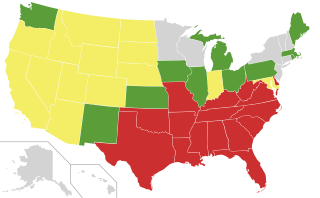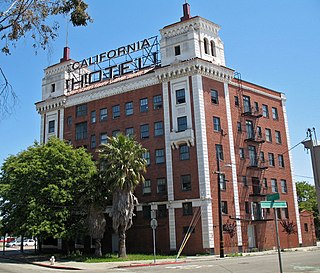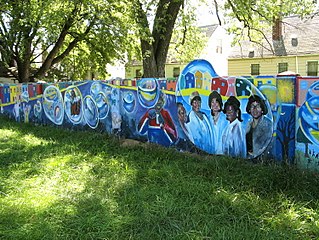 W
WThe 1949 Sun Bowl controversy refers to the student protests at Lafayette College in Easton, Pennsylvania, after a Sun Bowl invitation was extended to the Lafayette Leopards football team under the condition that the African American player, David Showell, would not play.
 W
WAfrican-American neighborhoods or black neighborhoods are types of ethnic enclaves found in many cities in the United States. Generally, an African American neighborhood is one where the majority of the people who live there are African American. Some of the earliest African-American neighborhoods were in New York City along with early communities located in Virginia. In 1830, there were 14,000 "Free negroes" living in New York City.
 W
WIn the United States, anti-miscegenation laws were laws passed by most states that prohibited interracial marriage and interracial sexual relations. Some such laws predate the establishment of the United States, some dating to the later 17th or early 18th century, a century or more after the complete racialization of slavery. Most states had repealed such laws by 1967, when the U.S. Supreme Court ruled in Loving v. Virginia that such laws were unconstitutional in the remaining 16 states. The term miscegenation was first used in 1863, during the American Civil War, by journalists to discredit the abolitionist movement by stirring up debate over the prospect of interracial marriage after the abolition of slavery.
 W
WBabbitt, Nevada, was a populated place established as a 1941 government housing facility for workers of the neighboring Hawthorne Naval Ammunition Depot. Subsequently, used as a Cold War radar station, remaining town structures include the school building at the intersection of 21st Street and Yorktown Avenue and numerous concrete building foundations. An RV park is located at the east side of the former community.
 W
WThe Black Codes, sometimes called Black Laws, were laws governing the conduct of African Americans. The best known of them were passed in 1865 and 1866 by Southern states, after the American Civil War, in order to restrict African Americans' freedom, and to compel them to work for low wages. Although Black Codes existed before the Civil War and many Northern states had them, it was the Southern U.S. states that codified such laws in everyday practice. In 1832, James Kent wrote that "in most of the United States, there is a distinction in respect to political privileges, between free white persons and free coloured persons of African blood; and in no part of the country do the latter, in point of fact, participate equally with the whites, in the exercise of civil and political rights."
 W
WBlack flight is a term applied to the migration of African Americans from predominantly black or mixed inner-city areas in the United States to suburbs and newly constructed homes on the outer edges of cities. While more attention has been paid to this since the 1990s, the movement of black people to the suburbs has been underway for some time, with nine million people having migrated from 1960 to 2000. Their goals have been similar to those of the white middle class, whose out-migration was called white flight: newer housing, better schools for their children, and attractive environments. From 1990 to 2000, the percentage of African Americans who lived in the suburbs increased to a total of 39 percent, rising 5 percent in that decade. Most who moved to the suburbs after World War II were middle class.
 W
WThe Black Theater of Ardmore is a historic theater building in Ardmore, Oklahoma, United States. It was built in 1922 during a time of racial segregation, when Ardmore's community of more than 2,000 African American residents had its own business district and its own residential area. The theater provided entertainment for black residents who were excluded from patronizing white theaters. It is also a symbol to the once-thriving black business district of Ardmore. It functioned as a theater until 1944, when it was sold to the Metropolitan African Methodist Episcopal Church. The building is listed on the National Register of Historic Places.
 W
WOn 16 October 1901, shortly after moving into the White House, President Theodore Roosevelt invited his adviser, the African American spokesman Booker T. Washington, to dine with him and his family; it provoked an outpouring of condemnation from southern politicians and press. This reaction affected subsequent White House practice and no other African American was invited to dinner for almost thirty years.
 W
WBooker T. Washington State Park is a former state park near the community of Institute in the U.S. state of West Virginia. The park was operated by the West Virginia Conservation Commission, Division of State Parks, from 1949 until the late 1950s.
 W
WThe California Hotel is a historic Oakland, California, hotel which opened in the early days of the Great Depression and became an important cultural center for the African-American community of San Francisco's East Bay during the 1940s, 50s and 60s. On June 30, 1988 the hotel was placed on the National Register of Historic Places.
 W
WCamp Robert Smalls was a United States Naval training facility, created pursuant to an order signed April 21, 1942 by Frank Knox, then Secretary of the Navy, for the purpose of training African-American seamen at a time when the USN was still segregated by race.
 W
WThe Constitution of the Commonwealth of Virginia is the document that defines and limits the powers of the state government and the basic rights of the citizens of the U.S. Commonwealth of Virginia. Like all other state constitutions, it is supreme over Virginia's laws and acts of government, though it may be superseded by the United States Constitution and U.S. federal law as per the Supremacy Clause.
 W
WThe Detroit Eight Mile Wall, also referred to as Detroit's Wailing Wall, Berlin Wall or The Birwood Wall, is a one-foot-thick (0.30 m), six-foot-high (1.8 m) separation wall that stretches about 1⁄2 mile (0.80 km) in length. 1 foot is buried in the ground and the remaining 5 feet is visible to the community. It was constructed in 1941 to physically separate Black and White homeowners on the sole basis of race. The wall no longer serves to racially segregate homeowners and, as of 1971, both sides of the barrier have been predominately Black.
 W
WFire Station No. 30, Engine Company No. 30 is a historic fire station and engine company in the South Los Angeles area of Los Angeles, California.
 W
WFive Row was a community for African American farmhands and their families who worked in the Reynolda Village and Reynolda House in Winston-Salem, North Carolina. It was characterized by two rows of 5 houses as well as a school house that was used on Sundays as a church. This community was situated in the most unattractive part of the estate, despite Reynolds' attempts to improve it. Residents of Five Row did not have the amenities that the rest of the estate possessed, however they had front porches and private hedges with flowers. The community was demolished in 1961 and has since been used for the construction of the city's second highway Silas Creek Parkway.
 W
WIn 1929, United States First Lady Lou Hoover invited Jessie De Priest, wife of Chicago congressman Oscar De Priest, to the traditional tea by new administrations for congressional wives at the White House. Oscar De Priest, a Republican, was the first African American elected to Congress in the 20th century and the first elected outside the South.
 W
WManiac Magee is a novel written by American author Jerry Spinelli and published in 1990. Exploring themes of racism and inequality, it follows the story of an orphan boy looking for a home in the fictional town of Two Mills. Two Mills is harshly segregated between the East and West, blacks and whites. He becomes a local legend for feats of athleticism and helpfulness, and his ignorance of sharp racial boundaries in the town. It is popular in middle school curricula, and has been used in social studies on the premises of reaction to racial identity and reading. A TV movie was released on February 23, 2003.
 W
WThe Negro Motorist Green Book was an annual guidebook for African-American roadtrippers. It was originated and published by African-American New York City mailman Victor Hugo Green from 1936 to 1966, during the era of Jim Crow laws, when open and often legally prescribed discrimination against African Americans especially and other non-whites was widespread. Although pervasive racial discrimination and poverty limited black car ownership, the emerging African-American middle class bought automobiles as soon as they could, but faced a variety of dangers and inconveniences along the road, from refusal of food and lodging to arbitrary arrest. In response, Green wrote his guide to services and places relatively friendly to African-Americans, eventually expanding its coverage from the New York area to much of North America, as well as founding a travel agency.
 W
WIn 1924, the Virginia General Assembly enacted the Racial Integrity Act. The act reinforced racial segregation by prohibiting interracial marriage and classifying as "white" a person "who has no trace whatsoever of any blood other than Caucasian." The act, an outgrowth of eugenist and scientific racist propaganda, was pushed by Walter Plecker, a white supremacist and eugenist who held the post of registrar of Virginia Bureau of Vital Statistics.
 W
WResidential segregation in the United States is the physical separation of two or more groups into different neighborhoods—a form of segregation that "sorts population groups into various neighborhood contexts and shapes the living environment at the neighborhood level". While it has traditionally been associated with racial segregation, it generally refers to any kind of sorting of populations based on some criteria.
 W
WSag Harbor Hills, Azurest, and Ninevah Beach Subdivisions Historic District (SANS) is an African American beachfront community in Sag Harbor, New York. Founded following World War II, the SANS community served primarily as a summer retreat for middle-class African American families during the post-WWII and Jim Crow era. African American families were not allowed at beachfront resorts, pools or beaches, and SANS began as a place of refuge from racial strife. The historic district is bordered by Hempstead Street, Richards Drive, Hampton Street, Lincoln Street, Harding Terrace, Terry Drive and the eastern end of Haven's Beach in Sag Harbor. It was placed on the National Register of Historic Places on July 10, 2019.
 W
WSt. Mary Catholic Church is a Roman Catholic church in Greensboro, North Carolina which originally served as the Catholic parish and school for African-American Catholics in Greensboro prior to desegregation.
 W
WSt. James Episcopal Church Lafayette Square, or St. James African Episcopal Church, founded in 1824, is a historic Episcopal church now located at 1024 W. Lafayette Avenue in the Lafayette Square Historic District of Baltimore, Maryland.